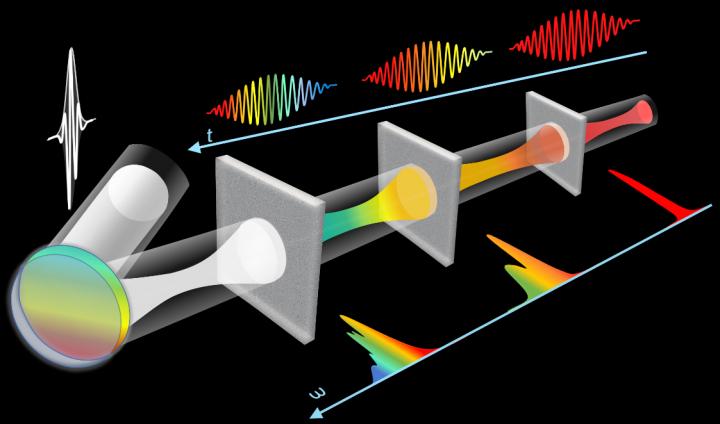
Credit: by Sheng Zhang, Zongyuan Fu, Bingbing Zhu, Guangyu Fan, Yudong Chen, Shunjia Wang, Yaxin Liu, Andrius Baltuska, Cheng Jin, Chuanshan Tian & Zhensheng Tao
Generating intense ultrashort pulses with high spatial quality has opened up possibilities for ultrafast and strong-field science. It is so important that the Nobel Prize in Physics 2018 was given to Dr. Strickland and Dr. Mourou for inventing a technique called chirped pulse amplification, which drives numerous ultrafast lasers worldwide. With the great advancement in the last decade, Yb-based ultrafast lasers have become highly popular, because they exhibit exceptional thermal efficiency, are low in cost and are highly flexible in adjusting pulse energies and repetition rates. However, the pulse durations from these lasers are usually not shorter than 100 fs or even 1 ps, which requires external pulse compression for applications. The existing supercontinuum generation (SCG) and pulse compression techniques are typically low in efficiency. Many of them require vacuum systems, vacuum-gas interfaces, and are, hence, expensive and complex to maintain. As a result, the applications of these techniques are still limited in a few specialized laboratories, and cannot be widely used in physics, femtochemistry and femtobiology labs, which represents the major applications of ultrafast lasers.
In a new paper published in Light Science & Application, a team of Chinese and Austrian scientists, led by Professor Zhensheng Tao from State Key Laboratory of Surface Physics and Department of Physics, Fudan University, Shanghai, China proposed and demonstrated that the formation of optical solitons during the propagation of strong ultrafast laser pulses in periodic layered Kerr media (PLKM) can serve as a simple, reliable and cost-effective solution for SCG and pulse compression. They found that the formation of the solitons is a result of the balance between the nonlinear Kerr self-focusing and the linear diffraction of the laser beam, which can support sustainable and long-distance nonlinear light-matter interaction, and hence enhance the SCG efficiency. More interestingly, by confining the beam propagation in these solitary modes, high spatial quality and spatio-spectral homogeneity can be achieved, reaching >85% compression efficiency. As a demonstration of such a method, the scientists used the compressed pulses to drive a highly nonlinear optical process, called high harmonic generation, producing bright and coherent extreme-ultraviolet and soft X-ray light from a gas target. The high harmonic process is extremely sensitive to the spatio-temporal quality of the compressed pulses, and it clearly demonstrated the great potential of this method. It is worth further mentioning that the total cost of constructing the PLKM SCG device is only ~$200. The reported method and technique will pave the way for future high-efficiency, reliable and cost-effective SCG and pulse compression of ultrafast lasers, which can be widely used in labs of ultrafast physics, chemistry and biology.
The high-efficiency, low-cost SCG and pulse compression method is centered around the studies on the formation and stability of the solitary states in a PLKM nonlinear resonator. With the solitary modes, the propagation of intense laser beam can be manipulated to generate the desired broad spectrum and high spatial quality. This method can support applications on ultrafast lasers with various pulse energies and repetition rates. The scientists summarize the advantages of their method:
“Compared to existing supercontinuum generation and pulse compression method, the method we proposed and demonstrated has four advantages: (1) It is very simple and cost-effective to construct and maintain, because it does not require vacuum systems or beam-pointing stabilization setups; (2) It is very flexible, which can be applied to ultrafast lasers with various energies and power; (3) It has very high efficiency, which can be as high as 85%; and (4) it is very stable. We believe this method can be widely introduce to many physics, chemistry and biology labs, for the scientists who use ultrafast laser but do not have specialties of constructing a broadband laser system.”
###
Media Contact
Zhensheng Tao
[email protected]
Related Journal Article
http://dx.




